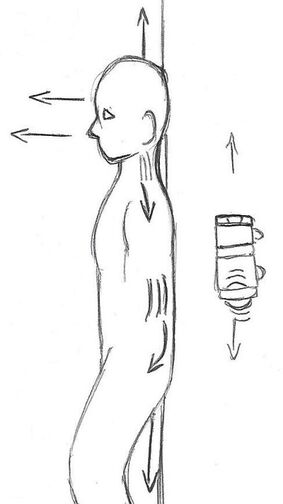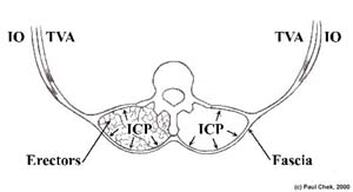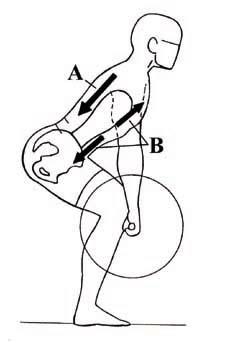 What really is the correct spinal posture? I've gotten this question many times from my students and massage clients alike. In short the answer hinges on what you're going to use it for. In day to day movements, Chinese martial art practice, and I would argue for the same in massage practice, correct spinal posture comes from lifting the crown point and pointing the sacrum, then tilting it depending on your use. What this does is straighten out the spine and expands it in order to grant space in between the vertebrae and take pressure off of any one point on the spine, as illustrated in the picture on the left. Why would we want to use this posture instead of the normal weight lifting posture? The short answer is that this posture takes pressure off of gross moving muscles of the body and puts the emphasis on the postural muscles. This posture is what is used primarily in the internal martial arts of Tai Chi Chuan, Xing Yi, Pa Kua, and various styles of Shaolin. The extension is meant to take the pressure off of the bigger and stronger gross moving muscles of the body, and to put the emphasis on the postural muscles to deter joint degeneration. The strength of postural muscles lasts much longer into older age, and, as their name indicates, are key players in adjustment of posture and postural ailments. This is because they support the joints better and are built to do so for longer periods of time. The spinal posture noted above is used to retrain the holding of the spine taking the pressure off of the main areas that are usually in need of adjustment (as chiropractors will tell you are...) Occ+C1, T12+L1, L5+S1. This posture does so by retraining the surrounding muscles of Illiopsoas (main contributor to L5+S1 problems), quadratus lumborum (secondary contributor to L5+S1 problems), Lumbar paraspinals (L5+S1), thoracolumbar paraspinals (T12+L1) Suboccipitals + scalenes (Occ+C1 and 'forward head carriage') This is done by holding the extension in our day to day movements. When holding this extended posture of the spine the above mentioned muscles work in unison with their antagonistic pair. Eventually after consistent practice relaxation is possible into this neutral position, bringing about greater balance for daily use and joint health. I advocate this training method for health practice and to hold as a 'default posture' during day to day activities. The reasoning behind this is because whatever you train your body to do becomes exaggerated with time. This also explains why the areas noted above are the norm for chiropractic adjustments. From the time of childhood the S curve is emphasized "shoulders back, chest out, butt back, and head up straight" this exaggerates that S curve overworking the muscles noted above, in time pulling the spine out of alignment. That being said the extension of the spine is not the be all end all posture, all of the time. There are times when the 'lifting posture' is needed, and that is when lifting heavy objects. Before we get into that lets explain what 'lifting posture' is. Lifting postureMainstream weightlifting postural requirement is usually the spinal S curve. While performing a deadlift, for example, the force you are working against is gravity, gravity always pulls down so we have to safeguard against its pull with the muscles surrounding the spine to avoid injury. There are various different theories on proper technique in lifting weights but they all hinge on maintaining the spine static. This usually entails the S curve in the spine and extensive use of spinal erectors and various other muscles in the abdominal wall for stabilization. The two methods noted below are the theory of intra-compartmental pressure, and intra-abdominal pressure mechanism. It should be noted here that without use of the above mentioned methods there runs a high risk of serious injury when lifting heavy loads of weight. As I said in the beginning it is important to keep in mind what we're using the posture for. If you want to look into those methods of tension and muscular use I highly recommend it. These topics are well outside the scope of this article, but great compliments to what I'm talking about... When lifting weights the goal is to build muscular strength, size, or endurance while working against resistance. In martial art, more importance is put on having the alignment to divert, project, or accept incoming force. It is a common idea in Chinese martial arts that acceptance and diversion of force are accomplished more easily through alignment and technique as opposed to muscular strength. Although one complements the other, alignment and technique is generally trained more often because that precision is something that lasts much longer than the strength gotten from muscular force in a single contraction or various contractions.
In conclusion I feel this elongated spinal/ hanging posture is meant for day to day life and realistic application toward routine actions, upright pushing and pulling. Lifting posture is meant for use in building muscular strength, and specifically lifting higher amounts of weight that require greater amount of support and should not be superimposed onto day to day actions unless moving heavy weight up from, or lowering down to the ground. Personally in clinical practice I have used this posture for correcting the above mentioned postural alignment problems and various other issues surrounding the spine and pain resulting from these misalignments. Comments are closed.
|
Your AuthorDaniel R. Hyde
Licensed Massage Therapist OIF, OEF Veteran U.S. Marine Corps Instructor of: Kwan Ying Do Kung Fu Tai Chi Chuan Chi Kung Tui Na, Chinese Massage Thai Massage Shiatsu, Japanese Massage Archives
May 2021
Categories |




 RSS Feed
RSS Feed
